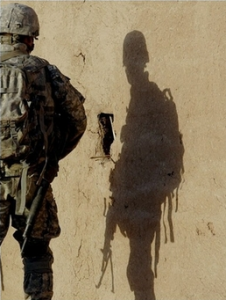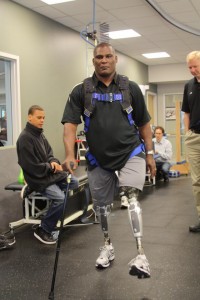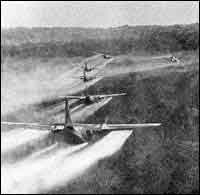Jan
26
HIDDEN IN PLAIN SIGHT
Filed Under Combat PTSD, Life, Peace, PTSD, TBI & PTSD, Tears of a Warrior, Trauma, War, Wisdom | Comments Off on HIDDEN IN PLAIN SIGHT
by Janet J. Seahorn, Ph.D

There is a phrase that one hears every now and then, Hidden in Plain Sight. Four simple words that eloquently reveal the complexity of the impact of trauma on one’s mind, heart, and soul. We see the person; we look at the eyes, the body language, the being’s form. The suffering is present in plain sight for all to witness. Yet, few do, lacking the keen observational heart skills required to notice anguish.
There are days I wish I didn’t see it – the faces of children battered by abuse and neglect; the adolescent’s depressive absorption into the ugly world of alcohol and drugs, and the veiled, but ever present ghosts of veterans, young and old carrying their memories of war. They haunt me as the world moves around their pain because it is hidden in plain sight.
Much like ‘Don’t Ask, Don’t Tell’, we are a nation that prefers to maintain our equilibrium at all cost. We tend to be uncomfortable with sorrow even when it stands knocking at our front door asking only for recognition and a bit of compassion.
We say we are a nation of empathy, yet often dismiss the humanity that exists in every person, especially those with whom we don’t agree. We argue we are intelligent, proficient thinkers, yet fight rigorously to disqualify any information that does not align with our personal paradigms/beliefs, whether true or misleading, without accurate evidence or data.
The answers to our current and future problems are available, but for too many they are hidden in plain sight. It will take incredible courage to look into our own minds and hearts searching for what is right and true. It will take courage and honest self-reflection to heal the hidden wounds of the wounded, but it can be done. What lies before us does not need to consume us with fear or apprehension. When confronted, trauma and pain can be overcome and no longer hidden or carried alone.
Light and sunshine are incredible healers.
Jan
17
WAITING FOR UNCLE SAM
Filed Under Tears of a Warrior, Today's War, Veteran Benefits, War | Comments Off on WAITING FOR UNCLE SAM
by Janet J. Seahorn, Ph.D

A film came out this fall called Waiting for Superman. It was a documentary on the state of education and our public/charter schools. Many educators perceived the information as “anti” teachers. As a teacher who has been in the field for many decades, I felt the film had many good points, yet, as most documentaries go, it did not address the issues of educating high needs students in the most accurate manner. So it is when dealing with supporting our troops when they return from combat.
First, let me state up front, I have seen and believe most of the individuals who work directly with our military veterans are committed, caring professionals. Every day they do their utmost to make a difference in healing the vet’s emotional and physical wounds. However, there continues to be incredible hurdles veterans must jump through to get the services they need to move forward. Government agencies, much like any huge organization, have far too many procedures, protocols, and paper work for any person to move through in a sane and timely manner. Paper work gets lost or misplaced; doctor appointments and therapy sessions can take months, even years to get into the structure, and classification methods may or may not accurately assess the circumstances of the person.
Many vets continue to report that too often the system uses over medication to solve a problem without proper supervision. What they are asking for are not more pills, but someone to talk to on a regular basis–someone who will listen and assist him in sorting out his experiences, someone who will provide recommendations for coping with the memories and the hurting.
Now, herein lies a huge obstacle – there simply aren’t enough qualified personnel on board to meet the needs of the enormous number of veterans requesting services. One counselor indicated that in her area there were only five therapist hired to handle a client population of 25,000 veterans. Do the math… that would mean each therapist would be responsible for 5,000 individuals – an impossible mission for any person to accomplish regardless of their expertise and dedication.
Some areas of the country are doing a much better job than others. Some vet centers have more resources and personnel to do the work necessary to make the difference in a timely manner. Every site wants to support their veterans, yet they may not have the means to do this effectively and efficiently. So this message is to our government, our elected officials, and Uncle Sam.
Our military and their families cannot afford to WAIT for the treatments they need to get better. They cannot WAIT weeks or months for a doctor’s appointment when the pain is getting worse every day. And they cannot WADE through the incredible amount of red tape to receive the treatments needed NOW! I know that those running the Veteran Centers and hospitals would love to have fewer forms and a more functional process. Surely, if we try we can do better. We can, with careful thought, provide a system that would better support our troops – past, present, and future.
If we send them, then we must mend them.
Jan
11
ANOTHER HAZARD OF WAR
Filed Under Agent Orange, Tears of a Warrior, War | Comments Off on ANOTHER HAZARD OF WAR
by Tony & Janet Seahorn

There are many Vietnam veterans who have and are continuing to suffer from exposure to AGENT ORANGE. For many, getting adequate information has been a challenge. Because of that challenge, we decided to put the following information on Agent Orange in this blog. We hope it will be of some help.
Presumption of Exposure — A veteran who, during active military, naval, or air service, served in the Republic of Vietnam during the period beginning on January 9, 1962 and ending on May 7, 1975, will be presumed to have been exposed to an herbicide agent during such service, unless there is affirmative evidence that establishes that the veteran was not exposed to any such herbicide agent.
Length of Exposure — There is no regulatory requirement as to how long the veteran was in Vietnam; even a few hours of service in country is sufficient to establish the presumption of exposure. The last date on which a veteran will be presumed to have been exposed to an herbicide agent will be the last date on which he or she served in the Republic of Vietnam during the period beginning on January 9, 1962 and ending on May 7, 1975.
Presumptive Service Connection (herbicide-related diseases)
If a veteran has one of the diseases listed in 38 C.F.R. § 3.309(e) (see Appendix A) and his/her exposure to an herbicide is either presumed, based on service in Vietnam, or otherwise proven by the evidence, the disease is presumed to be related to the in-service exposure.
The all inclusive list, according to the VA site now reads:
- Acute and Subacute Peripheral Neuropathy
A nervous system condition that causes numbness, tingling, and motor weakness. Under VA’s rating regulations, it must be at least 10% disabling within 1 year of exposure to Agent Orange and resolve within 2 years after the date it began. - AL Amyloidosis
A rare disease caused when an abnormal protein, amyloid, enters tissues or organs. - B Cell Leukemias
Cancers which affect B cells, such as hairy cell leukemia. - Chloracne (or Similar Acneform Disease)
A skin condition that occurs soon after dioxin exposure and looks like common forms of acne seen in teenagers. Under VA’s rating regulations, chloracne (or other acneform disease similar to chloracne) must be at least 10% disabling within 1 year of exposure to Agent Orange. - Chronic Lymphocytic Leukemia
A disease that progresses slowly with increasing production of excessive numbers of white blood cells. - Diabetes Mellitus (Type 2)
A disease characterized by high blood sugar levels resulting from the body’s inability to respond properly to the hormone insulin. - Hodgkin’s Disease
A malignant lymphoma (cancer) characterized by progressive enlargement of the lymph nodes, liver, and spleen, and by progressive anemia. - Ischemic Heart Disease
A disease characterized by a reduced supply of blood to the heart. - Multiple Myeloma
A cancer of specific bone marrow cells that is characterized by bone marrow tumors in various bones of the body. - Non-Hodgkin’s Lymphoma
A group of cancers that affect the lymph glands and other lymphatic tissue. - Parkinson’s Disease
A motor system condition with symptoms that include trembling of the limbs and face and impaired balance. - Porphyria Cutanea Tarda
A disorder characterized by liver dysfunction and by thinning and blistering of the skin in sun-exposed areas. Under VA’s rating regulations, it must be at least 10% disabling within 1 year of exposure to Agent Orange. - Prostate Cancer
Cancer of the prostate; one of the most common cancers among men. - Respiratory Cancers
Cancers of the lung, larynx, trachea, and bronchus. - Soft Tissue Sarcoma (other than Osteosarcoma, Chondrosarcoma, Kaposi’s sarcoma, or Mesothelioma)
A group of different types of cancers in body tissues such as muscle, fat, blood and lymph vessels, and connective tissues.
Here is the link, as well:
http://www.publiche alth.va.gov/ exposures/ agentorange/ diseases. asp#veterans

